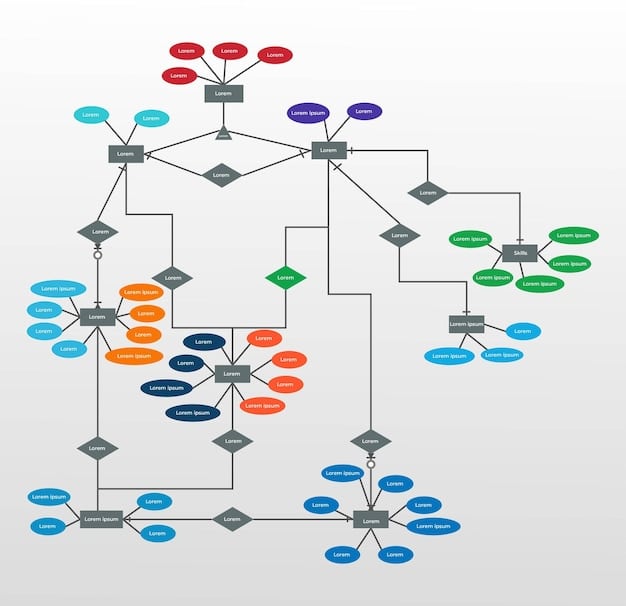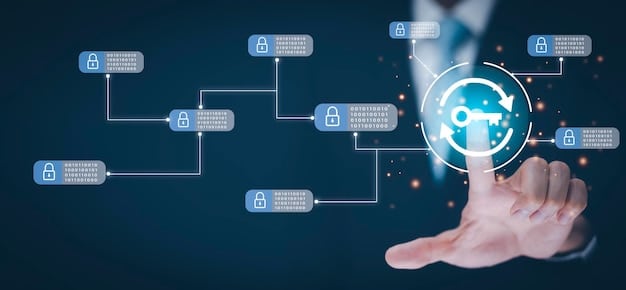New US Cybersecurity Regulations: A Business Guide for 2026

New US Federal Cybersecurity Regulations set to take effect by January 2026 require businesses to implement enhanced security measures, including vulnerability management, incident response plans, and regular security assessments to protect against evolving cyber threats.
The landscape of cybersecurity is constantly evolving, and with that evolution comes the necessity for more stringent regulations. The clock is ticking for businesses across the United States to prepare for the **new US Federal Cybersecurity Regulations: What Businesses Must Do by January 2026**. Compliance is not merely a suggestion, it’s a requirement that can significantly impact your organization’s operations, reputation, and bottom line.
Understanding the Urgency of the New Cybersecurity Regulations
As cyber threats become increasingly sophisticated, the US federal government is bolstering its defense mechanisms. The new cybersecurity regulations are designed to minimize risks, protect sensitive data, and ensure the resilience of critical infrastructure. Understanding why these regulations are being implemented is the first step towards achieving compliance.
The Growing Threat Landscape
Cyberattacks are on the rise, targeting businesses of all sizes, across various industries. Ransomware attacks, data breaches, and supply chain compromises are becoming more frequent and sophisticated.
Protecting Critical Infrastructure
Many of the cybersecurity regulations focus on protecting the nation’s critical infrastructure. This includes industries like energy, transportation, and healthcare, where disruptions can have far-reaching consequences.
These regulations are designed to ensure the confidentiality, integrity, and availability of sensitive data. Companies failing to comply face significant penalties, including hefty fines and legal repercussions.
- Data protection
- Ensuring resilience of critical infrastructure
- Avoiding penalties

These regulations reflect a proactive approach to cybersecurity, aiming to mitigate risks before they escalate. Compliance isn’t just about ticking boxes, it is about building a secure foundation for your business that protects against evolving threats.
Key Components of the New Federal Cybersecurity Regulations
The new cybersecurity regulations encompass a wide range of requirements, each designed to enhance an organization’s security posture. Understanding these components is crucial for developing a comprehensive compliance strategy.
Vulnerability Management
This involves identifying, assessing, and remediating vulnerabilities in your systems and applications. Regular security scans and penetration testing are essential for maintaining a strong security posture.
Incident Response Planning
Having a well-defined incident response plan is critical for minimizing the impact of a cyberattack. This plan should outline procedures for detecting, responding to, and recovering from security incidents.
Companies are mandated to have documented cybersecurity policies and procedures. These policies should cover everything from data encryption to access controls to employee training.
- Regular security scans
- Well-defined incident response plan
- Documented cybersecurity policies
These components work together to create a layered defense against cyber threats. A robust vulnerability management program reduces the attack surface, while an incident response plan ensures that your business can quickly recover from an attack.
Developing a Comprehensive Compliance Strategy
Achieving compliance with the new cybersecurity regulations requires a strategic approach. It involves assessing your current security posture, identifying gaps, and implementing the necessary controls.
Assess Your Current Security Posture
Begin by conducting a thorough assessment of your existing security controls. This includes evaluating your infrastructure, applications, and data security practices.
Identify Compliance Gaps
Once you have a clear understanding of your current security posture, identify any gaps in your compliance with the new regulations. This may involve reviewing the regulatory requirements and comparing them to your existing controls.
Implementing robust authentication and authorization mechanisms is critical for protecting sensitive data. This includes multi-factor authentication, strong password policies, and role-based access control.
- Assess existing security controls
- Address compliance gaps
- Implement multi-factor authentication
A comprehensive compliance strategy should also include employee training. Employees are on the front lines of cybersecurity, and they need to be trained to recognize and respond to security threats.

Implementing Essential Security Controls
Meeting the requirements of the new cybersecurity regulations requires the implementation of several essential security controls. These controls act as the building blocks of a robust security program.
Data Encryption
Encrypting sensitive data, both in transit and at rest, is essential for protecting it from unauthorized access. Use strong encryption algorithms and manage encryption keys effectively.
Access Controls
Implement strict access controls to limit who can access sensitive data and systems. Use the principle of least privilege, granting users only the access they need to perform their job duties.
Regularly review and update your security controls to address emerging threats and vulnerabilities. This includes patching systems, updating software, and implementing new security technologies.
- Encrypt sensitive data
- Implement strict access control
- Consistently update security controls
Implementing these security controls requires a combination of technology, policies, and procedures. The goal is to create a layered defense that protects against a wide range of cyber threats.
The Role of Security Awareness Training
Security awareness training plays a critical role in ensuring that employees understand their responsibilities in protecting the organization’s data and systems. A well-trained workforce is a key asset in the fight against cybercrime.
Educate Employees on Common Threats
Provide employees with regular training on common cyber threats, such as phishing attacks, malware, and social engineering. Teach them how to recognize and avoid these threats.
Promote a Culture of Security Awareness
Foster a culture of security awareness throughout the organization. Encourage employees to report suspicious activity and to stay up-to-date on the latest security threats.
Conduct regular phishing simulations to test employees’ susceptibility to phishing attacks. Use the results of these simulations to identify areas where additional training is needed.
- Educate employees on threats
- Promote understanding of threats
- Conduct phishing stimulations
Security awareness training should be ongoing and interactive. Use a variety of training methods, such as online courses, workshops, and simulations, to keep employees engaged.
Preparing for Audits and Assessments
As part of the new cybersecurity regulations, businesses may be required to undergo audits and assessments to verify compliance. Preparing for these audits in advance can help to ensure a smooth and successful process.
Maintain Detailed Documentation
Keep detailed records of your security policies, procedures, and controls. This documentation will be essential for demonstrating compliance during an audit.
Conduct Regular Internal Audits
Perform regular internal audits to identify any gaps in your compliance. Use the results of these audits to make necessary improvements and corrections.
Work with a qualified cybersecurity consultant to prepare for audits and assessments. A consultant can provide guidance on regulatory requirements and help you to develop a comprehensive compliance program.
- Maintain compliance documentation
- Perform internal compliance audits
- Work with a qualified consultant
Preparing for audits and assessments is an ongoing process. By continuously monitoring your security posture and maintaining detailed documentation, you can ensure that you are always ready to demonstrate compliance.
| Key Point | Brief Description |
|---|---|
| 🛡️ Vulnerability Management | Identify, assess, and fix vulnerabilities in systems. |
| 🚨 Incident Response | Plan for and respond to security incidents effectively. |
| 🔑 Access Controls | Limit data and system access to authorized personnel only. |
| 👨🏫 Employee Training | Educate employees on cybersecurity threats and best practices. |
[Frequently Asked Questions]
▼
The primary deadline is January 2026. However, specific components may have earlier milestones. Start planning now to ensure timely compliance.
▼
These regulations primarily affect businesses that handle sensitive data or operate within critical infrastructure sectors in the United States.
▼
Penalties for non-compliance can include significant fines, legal repercussions, and damage to your organization’s reputation and customer trust.
▼
Security policies should be reviewed and updated at least annually, or more frequently if there are significant changes to your business or the threat landscape.
▼
Consult the official government websites and publications related to cybersecurity regulations, and seek advice from cybersecurity professionals.
Conclusion
As January 2026 approaches, businesses throughout the United States must understand and prepare for the upcoming cybersecurity standards. By embracing a proactive stance, executing vital security measures, and staying abreast of changes, companies can safeguard their operations and ensure compliance. The new regulations present challenges and opportunities to fortify digital defenses and establish a more resilient and secure environment.





